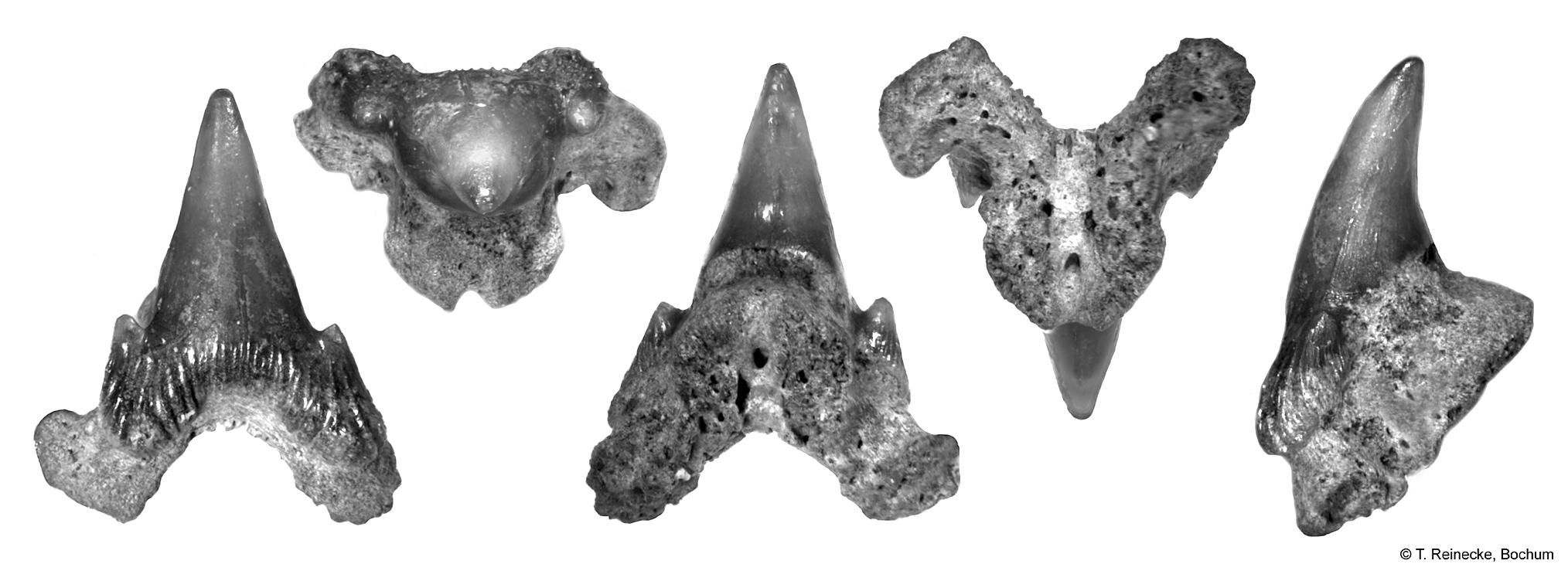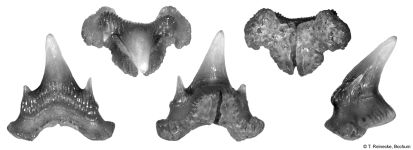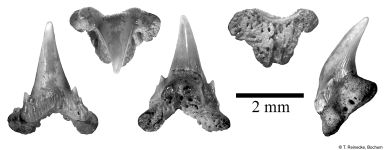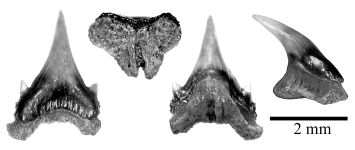Scyliorhinus suelstorfensis
Reinecke, 2014
Classification: Elasmobranchii Carcharhiniformes Scyliorhinidae
Reference of the original description
Two new scyliorhinid shark species (Elasmobranchii, Carcharhiniformes, Scyliorhinidae), from the Sülstorf Beds (Chattian, Late Oligocene) of the southeastern North Sea Basin, northern Germany. Palaeovertebrata, 38(1), 1–8
Two new scyliorhinid shark species (Elasmobranchii, Carcharhiniformes, Scyliorhinidae), from the Sülstorf Beds (Chattian, Late Oligocene) of the southeastern North Sea Basin, northern Germany. Palaeovertebrata, 38(1), 1–8
Types
Scyliorhinus suelstorfensis
Holotype: SMF(fossil): P 9815; Paratype: SMF(fossil): P 9816; SMF(fossil): P 9817;
Scyliorhinus suelstorfensis
Holotype: SMF(fossil): P 9815; Paratype: SMF(fossil): P 9816; SMF(fossil): P 9817;
Description:
Citation: Scyliorhinus suelstorfensis Reinecke, 2014: In: Database of fossil elasmobranch teeth www.shark-references.com, World Wide Web electronic publication, Version 01/2026
Please send your images of "Scyliorhinus suelstorfensis" to info@shark-references.com

Scyliorhinus suelstorfensis Reinecke, 2014; holotype, Sülstorf Formation, early-middle Chattian, late Oligocene; Kobrow, Germany, coll. Senckenberg Research Institute and Natural History Museum, Frankfurt SMF P 9815 © T. Reinecke, Bochum.

Scyliorhinus suelstorfensis Reinecke, 2014; holotype, Sülstorf Formation, early-middle Chattian, late Oligocene; Kobrow, Germany, coll. Senckenberg Research Institute and Natural History Museum, Frankfurt SMF P 9815 © T. Reinecke, Bochum.
Description
Description (Reinecke, 2014) [20689]: The available teeth include two specimens derived from anterior files and one from a lateral file. The holotype, an anterior tooth, has a high, upright crown with an acute triangular, conical cusp and one pair of low cusplets. The cusp has similarly convex labial and lingual faces, separated by indistinct, straight cutting edges that extend from the apex to the basis of the cusp. The axially deepened and laterally protruding labial crown basis markedly overhangs the labial root face. The basal labial crown face is ornamented with strong, curved or straight ridges which in apical direction diminish at the height of the cusplets. The lower part of the lingual crown face is covered with very faint ridges. These are more strongly developed on the lingual side of the cusplets. The root has well separated lobes which are laterally and labially much expanded and well rounded. The lingual protuberance is very distinct. The labial root face is much lower than the margino-lingual root faces. These are strongly deepened and concave below the cusplets and bear 1 or 2 large foramina near the edge with the basal root face. The slightly corroded basal face is rather flat. It is divided by a shallow nutrient groove with two larger foramina in non-central positions. Additional small foramina are scattered on the labial and lingual root faces.
The paratype 1 (SMF P 9816) is morphologically similar to the holotype. The cusp is more slender and its lingual curvature more pronounced. This specimen may therefore come from a more anterior position than the holotype. The paratype 2 (SMF P 9817) represents a lateral file, because the cusp is lower - at similar tooth width as the anterior teeth - and noticeably inclined distally, and the cusplets are sharper and clearly separated from the cusp. The well preserved root shows several foramina near the basis of the labial root face, not seen in the corroded roots of the anterior teeth. All other characteristics, in particular the shape of root lobes and the crown ornamentation, are very similar to those of the anterior teeth.
Description (Reinecke, 2014) [20689]: The available teeth include two specimens derived from anterior files and one from a lateral file. The holotype, an anterior tooth, has a high, upright crown with an acute triangular, conical cusp and one pair of low cusplets. The cusp has similarly convex labial and lingual faces, separated by indistinct, straight cutting edges that extend from the apex to the basis of the cusp. The axially deepened and laterally protruding labial crown basis markedly overhangs the labial root face. The basal labial crown face is ornamented with strong, curved or straight ridges which in apical direction diminish at the height of the cusplets. The lower part of the lingual crown face is covered with very faint ridges. These are more strongly developed on the lingual side of the cusplets. The root has well separated lobes which are laterally and labially much expanded and well rounded. The lingual protuberance is very distinct. The labial root face is much lower than the margino-lingual root faces. These are strongly deepened and concave below the cusplets and bear 1 or 2 large foramina near the edge with the basal root face. The slightly corroded basal face is rather flat. It is divided by a shallow nutrient groove with two larger foramina in non-central positions. Additional small foramina are scattered on the labial and lingual root faces.
The paratype 1 (SMF P 9816) is morphologically similar to the holotype. The cusp is more slender and its lingual curvature more pronounced. This specimen may therefore come from a more anterior position than the holotype. The paratype 2 (SMF P 9817) represents a lateral file, because the cusp is lower - at similar tooth width as the anterior teeth - and noticeably inclined distally, and the cusplets are sharper and clearly separated from the cusp. The well preserved root shows several foramina near the basis of the labial root face, not seen in the corroded roots of the anterior teeth. All other characteristics, in particular the shape of root lobes and the crown ornamentation, are very similar to those of the anterior teeth.
Remarks
shark-references Species-ID=14031;
shark-references Species-ID=14031;
References
Combining palaeontological and neontological data shows a delayed diversification burst of carcharhiniform sharks likely mediated by environmental change. Scientific Reports, 12, Article 21906
DOI: 10.1038/s41598-022-26010-7
Combining palaeontological and neontological data shows a delayed diversification burst of carcharhiniform sharks likely mediated by environmental change. Scientific Reports, 12, Article 21906
DOI: 10.1038/s41598-022-26010-7






















